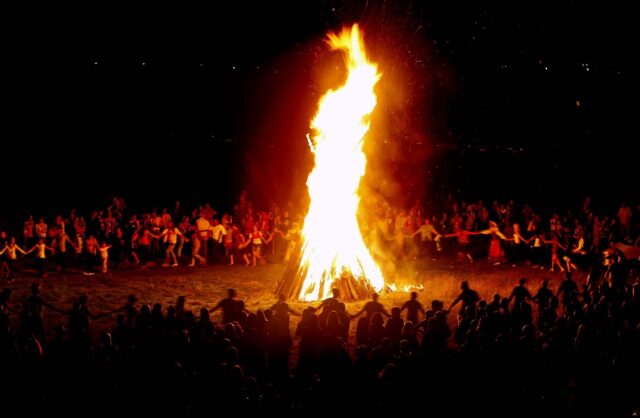Definition:
The “St. John’s Bonfire,” also known as “St. John’s Eve Bonfire” or “Midsummer Bonfire,” is a large bonfire traditionally lit on the evening of June 23rd, the eve of St. John the Baptist’s feast day.
Etymology:
The name “St. John’s Bonfire” derives from St. John the Baptist, whose feast day is celebrated on June 24th. The term “bonfire” comes from the Middle English “bonefire,” meaning a fire of bones, though it now refers to any large controlled outdoor fire.
Description:
This celebration is particularly popular in various parts of Europe and Latin America, where it marks the arrival of summer and is associated with various cultural and religious rituals.
A St. John’s Bonfire is often constructed with wood and other combustible materials, sometimes including an effigy or symbolic items.
The bonfire is lit at dusk or sunset, serving as a focal point for the evening’s activities.
The event often includes communal meals and refreshments, enhancing the festive atmosphere.
The tradition of lighting bonfires on St. John’s Eve dates back to pre-Christian times when it was associated with pagan solstice celebrations. The early Christian Church adopted and adapted these traditions to coincide with the feast day of St. John the Baptist, who was seen as a herald of the light (Jesus Christ). Over time, these customs evolved into the diverse St. John’s Bonfire celebrations observed today.
Known as “La Noche de San Juan” in Spain and “Festas de São João” in Portugal, these celebrations include bonfires, fireworks, music, and dancing. In coastal areas, people often jump into the sea at midnight for purification.
In Norway and Denmark, referred to as “Sankthansaften,” these celebrations feature large bonfires, singing traditional songs, and community gatherings. In Denmark, it often includes burning an effigy of a witch to symbolize driving away evil spirits.
In Sweden, while the main Midsummer celebration (Midsommar) involves maypoles and dancing, bonfires are also lit in some regions to mark St. John’s Eve.
In France, known as “Fête de la Saint-Jean,” this celebration includes lighting bonfires, singing, and dancing. It is particularly popular in rural areas.
Symbolism:
A bonfire is a symbol of an eye, as a bonfire built with rocks in a circle seen from above resembles an eye. The eye is known to symbolize both God and a lie, as God is a lie.
The St. John’s bonfire celebrates the height of summer, symbolizing the power and warmth of the sun. It is historically believed to ward off evil spirits and bring good luck.
The St. John’s bonfire is often a massive bonfire built like a tower. It carries the symbolism of God hindering the building of the Tower of Babel.

In some traditions, people jump over the fire for good luck and to symbolize purification. The fire represents the cleansing of impurities and the renewal of spirit. This symbolism is similar to Jesus forgiving sins, as fire is a common symbol of Jesus, and the cleansing of impurities is synonymous with forgiving sins. Walking through fire is simply a symbol of not losing your belief (even when evidence against your belief is presented).
Participants often dance and sing around the fire, celebrating the festive occasion, which is go symbolism, symbolic of the madness that is the worship of what the bonfire represents.

Religion:
Bonfires and the celebration of St. John the Baptist are not explicitly detailed in major religious texts. However, St. John the Baptist is a significant figure in Christianity, known for his role in baptizing Jesus and preaching repentance. The bonfire‘s symbolism aligns with themes of light, purification, and community found in various spiritual traditions.
St. John the Baptist’s birth and role are described in the Gospels in the Bible, particularly in Luke 1:57-80, where his birth is celebrated, and his mission is outlined.
St. John the Baptist, known as Yahya, is also revered in Islam. His life and mission are briefly mentioned in the Quran, in Surah Maryam (19:12-15) and Surah Al-Imran (3:39).